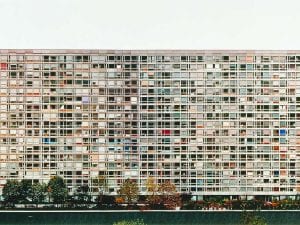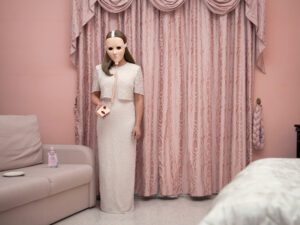Wellcome Collection London has opened the second part of a year-long exploration into human consciousness. States of Mind: Tracing the Edges of Consciousness examines the universal topic of conscious experience. This major exhibition brings together artists, psychologists, philosophers and neuroscientists to investigate the terrain between consciousness and unconsciousness and features historical material, objects, artworks and an evolving programme of contemporary art installations. Following on from Ann Veronica Janssens’ disorientating mist installation yellowbluepink which probed the nature of individual perception, States of Mind further questions the reliability of our inner world and subjective experience. The show explores phenomena such as synaesthesia, sleepwalking, memory loss and anaesthesia, and examines what happens when our conscious experience is undermined through dysfunctional experiences of perception or through loss of consciousness. We speak to curator Emily Sargent about the exhibition.
A: What initially inspired the theme of this exhibition?
ES: Consciousness felt like an ideal subject for an exhibition at Wellcome Collection. It’s a rich and fascinating topic, which is both familiar and mysterious. It’s a universal experience, intimately connected with the human condition but, while we all know what it is to be conscious, many questions surrounding its nature still remain unanswered. These questions have been discussed and reframed for hundreds of years by philosophers, writers and artists; and it is now being claimed as the next great frontier for neuroscience.
We’ve approached this vast subject through a range of experiences from the edges of consciousness, touching on the wonder and fragility of our internal lives and looking at ways in which philosophy; art and folklore have established frameworks of understanding for our conscious experience. For example, the nightmarish hallucinations of sleep paralysis, a condition in which conscious awareness returns during sleep. Unlike any other kind of bad dream, this phenomenon gives rise to an extraordinary range of distressing symptoms and is thought to be the inspiration for, among other things, the incubus myth depicted in Fuseli’s drawing of the Nightmare and some alien abduction tales.
We explore language and memory as tools of conscious selfhood and examine to what extent we rely on these functions to navigate the space between our internal and external lives. These processes allow for some of the most magical aspects of our conscious life, and consequences of the loss of them can be devastating. Artist Shona Illingworth has worked with neuro-pyschologists to explore the impact of amnesia on ‘Claire’, who describes “the past as a place you can’t enter and the future a space you can’t imagine.”
Finally we discover how neuroscience is are pushing back the very definitions of what we understand consciousness to be in the study of patients traditionally thought beyond awareness. This diversity of understanding and experience provides the opportunity to bring together a truly varied and wonderful collection of objects, artworks and films to explore this broad, eclectic subject, which is at once both unique and universal.
A: Could you take us through the variety of work on show – which is the most unusual piece?
ES: The range of objects on show is incredibly diverse. There are exquisite ink drawings by Santiago Ramón y Cajal, the Spanish neuroscientist who identified the role of neurons in the nervous system and realised the significance of the connections between these neurons; handwritten notes from the Francis Crick’s archive which show he was working on a scientific understanding of consciousness until the day of his death. A series of elegant watercolours by American illustrator Jean Holabird bring Nabokov’s description of his synaesthetic alphabet to life; while a synaesthetic training programme might just help non-synaesthetes see the world, or at least the alphabet, in new and colourful ways. There is a murderous somnambulist lurking in the gallery in the form of Goshka Macuga’s sculpture; and a powerful study of the care and ethics of treating patients in a vegetative state in Aya Ben Ron’s film, Shift. One of the most extraordinary exhibits shows a series of brain scan responses by patients thought to be beyond any kind of conscious awareness, diagnosed as vegetative. It’s drawn from research by neuroscientist Adrian Owen who discovered around 20% of the patients he scanned could respond to his questions by imagining certain tasks. It’s an incredibly powerful and moving experience to read the responses. But then there’s also a plasticine model from Francis Crick’s archive of work on consciousness; that’s pretty unusual too.
A: How does this exhibition plan to expand upon Ann Veronica Janssen’s earlier exploration of perception at Wellcome?
ES: Ann Veronica Janssens’s installation explored the process of perception, pushing it to its limit in her all-encompassing coloured mist environment. The work prioritised experience, giving our conscious experience a renewed emphasis while setting up a tension between individual and collective experiences. In terms of the relationship between the two different projects, Ann Veronica’s work beautifully set up the subject of consciousness by reminding us to notice the wonder of everyday awareness, by simultaneously limiting and prioritising it.
A: What do you hope that the viewer will take away from the changing installations and exhibits throughout the show’s year-long run?
ES: The changing installations allow us to program several really significant projects. The first of these, Imogen Stidworthy’s The Whisper Heard explores the experience of a stroke patient suffering from aphasia, contrasting his loss of language with the emergence of language in a young child. The second installation, on show from May, H.M by Kerry Tribe brings to life some of the many interviews given to pyschologists and memory researchers by a man with severe amnesia, unable to form memories of more than 20 seconds. The final project explores individual and cultural amnesia through the work of Shona Illingworth.
This rolling program reminds us there is no one defining account of consciousness; that the subject is continually evolving with each perspective. Each installation gives voice to a particular experience of consciousness; one among many.
States of Mind: Tracing the Edges of Consciousness, until 16 October 2016,
For more information, visit wellcomecollection.org.
Follow us on Twitter @AestheticaMag for the latest news in contemporary art and culture.
Credits
1. Imogen Stidworthy, The Whisper Heard, 2003. Installation view at Matt’s Gallery, London. Courtesy of the artist, Matt’s Gallery, London and Galerie Akinci, Amsterdam.





